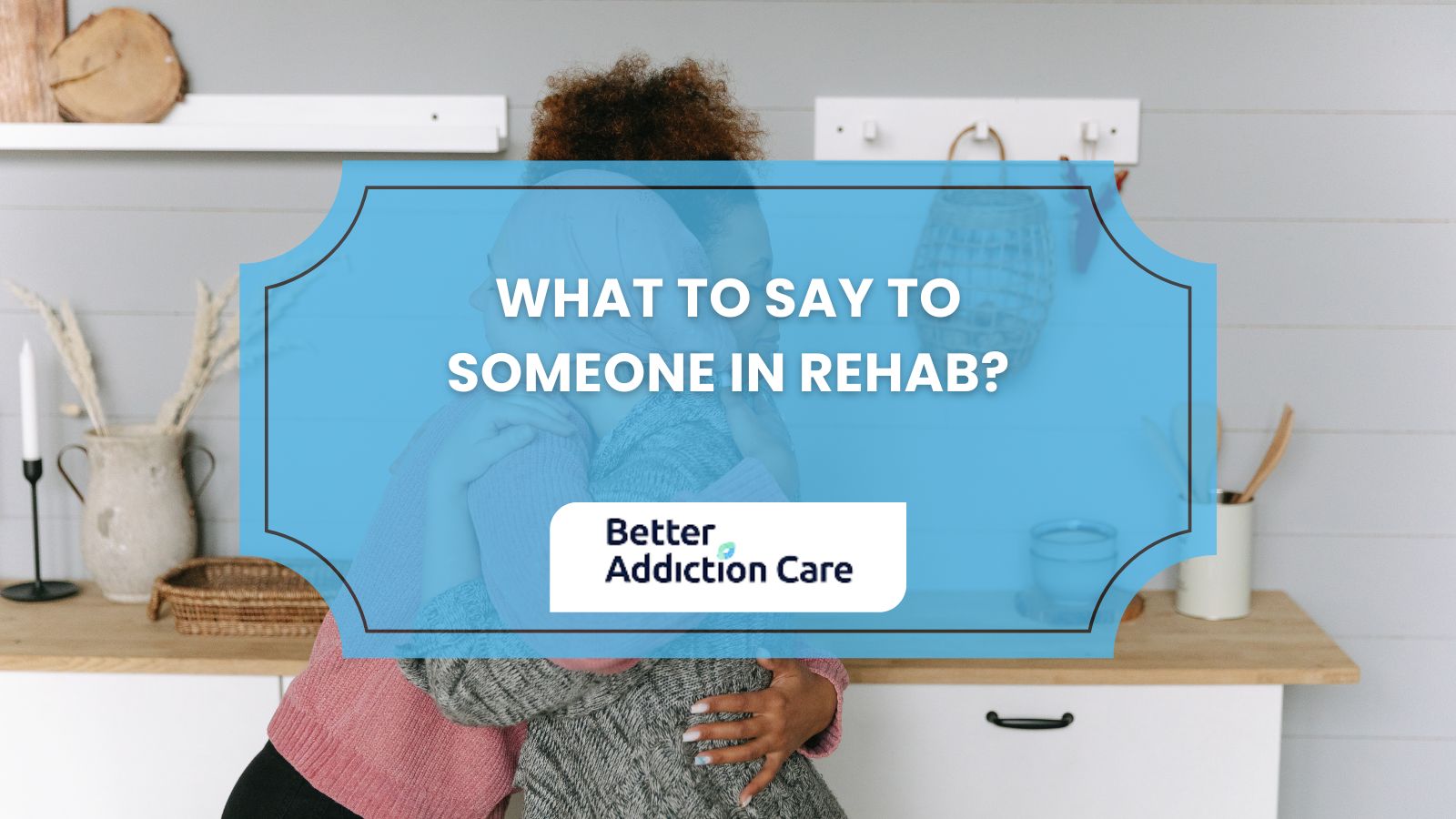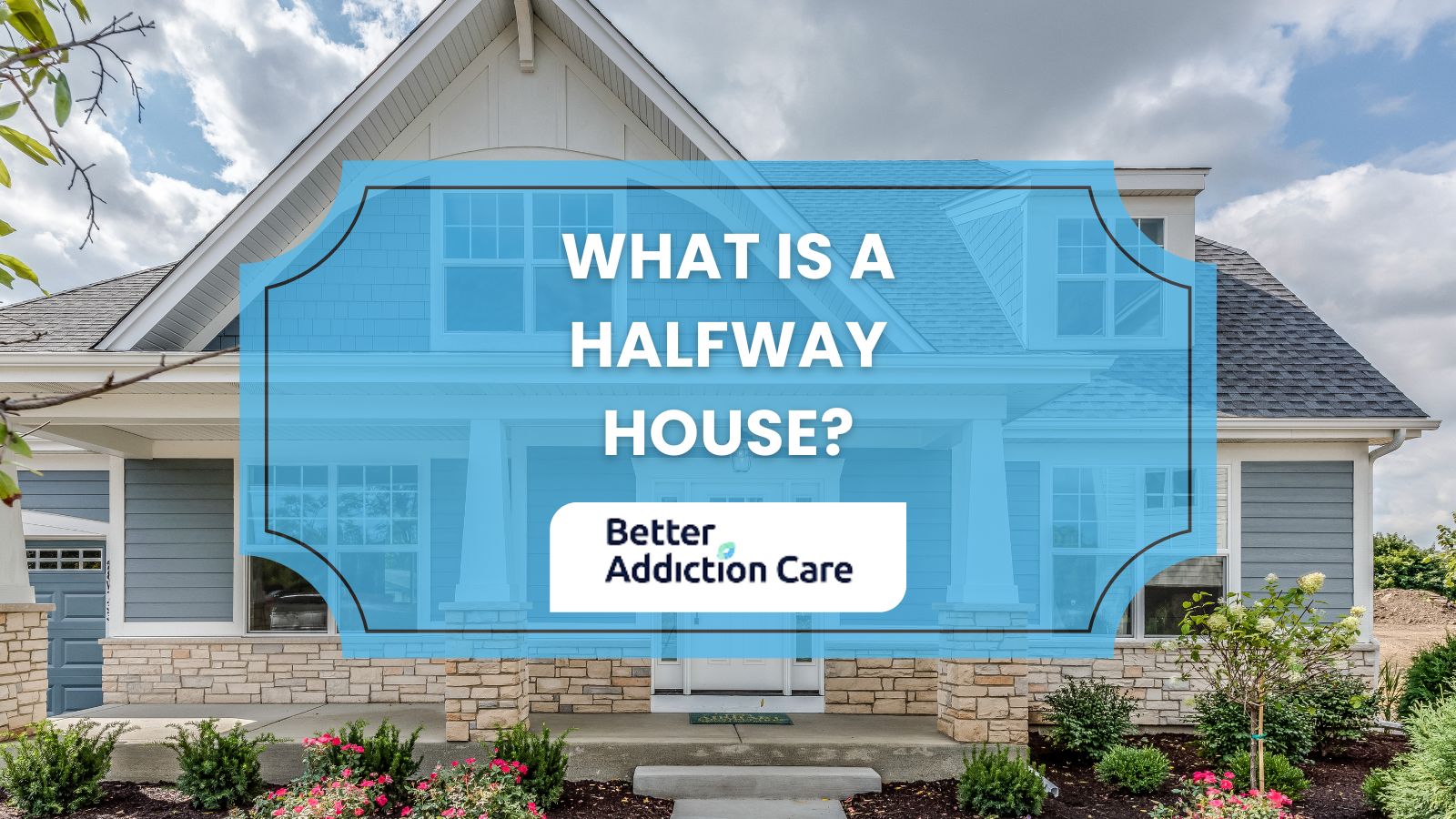What Is Drug Rehab? Definition, Types, Programs, Near Me
Drug rehab is a structured process of addiction treatment that combines medical and psychological care to help individuals recover from substance dependence. The need for structured addiction rehab programs has grown due to rising substance use disorders, requiring specialized approaches for lasting recovery. According to the Substance Abuse and Mental Health Services Administration (SAMHSA), in 2023, more than 95% of individuals who needed drug rehabilitation did not receive it.
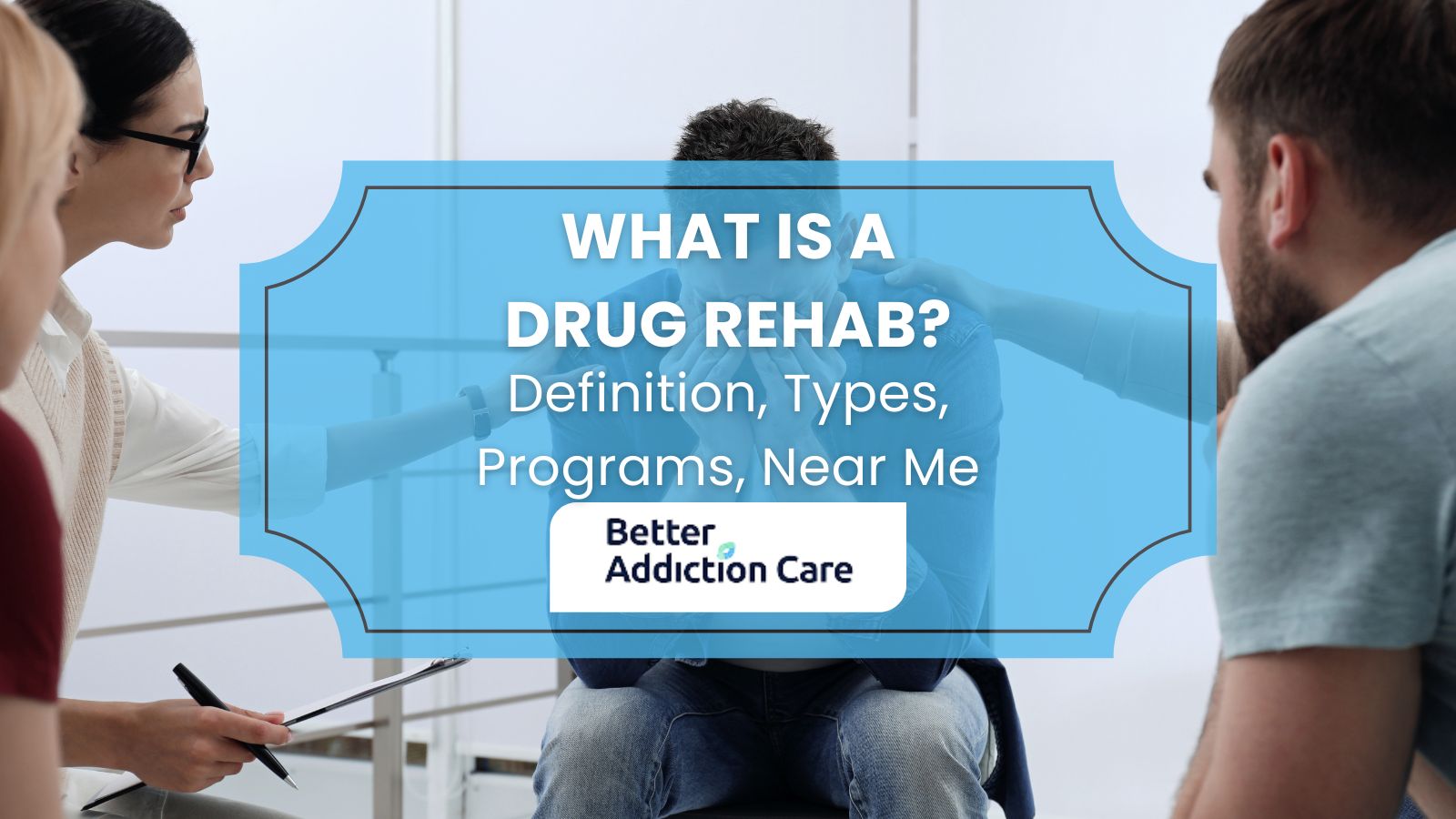
The types of rehab centers include inpatient, outpatient, and partial hospitalization programs (PHP), each offering different levels of care. Inpatient rehab provides 24-hour supervision for those with severe addiction, while outpatient treatment allows individuals to receive therapy while maintaining daily responsibilities. PHP offers intensive treatment without full-time residential care.
The main programs in rehab include detox, evidence-based therapies, and relapse prevention strategies. Detox helps manage withdrawal symptoms under medical supervision. Cognitive Behavioral Therapy (CBT) and Medication-Assisted Treatment (MAT) address substance dependence and behavioral patterns. Dual diagnosis treatment focuses on individuals with co-occurring mental health disorders, improving long-term recovery outcomes.
To find addiction treatment programs near you, individuals use the Substance Abuse and Mental Health Services Administration's (SAMHSA) treatment locator tool. Key factors when selecting a rehab center include accreditation, use of evidence-based therapies, individualized treatment plans, and strong aftercare support. According to the National Institute on Drug Abuse (NIDA) in the 2020 study "Drugs, Brains, and Behavior: The Science of Addiction," most individuals need at least 90 days of treatment for successful recovery.
What Is Drug Rehab?
Drug rehab is a structured addiction treatment program designed to help individuals stop compulsive substance use and regain control over their lives. Addiction rehab programs include medical and psychological care to address both physical dependence and behavioral patterns associated with addiction. Treatment settings vary, with inpatient rehab providing 24-hour care and outpatient rehab allowing individuals to continue daily activities while receiving therapy. According to the National Institute on Drug Abuse (NIDA) in the 2020 study "Drugs, Brains, and Behavior: The Science of Addiction," inpatient treatment is available in 24% of facilities, while 43% of individuals receive outpatient care after hospital discharge. The study also reports that most individuals require at least 90 days of treatment for the best chances of recovery.
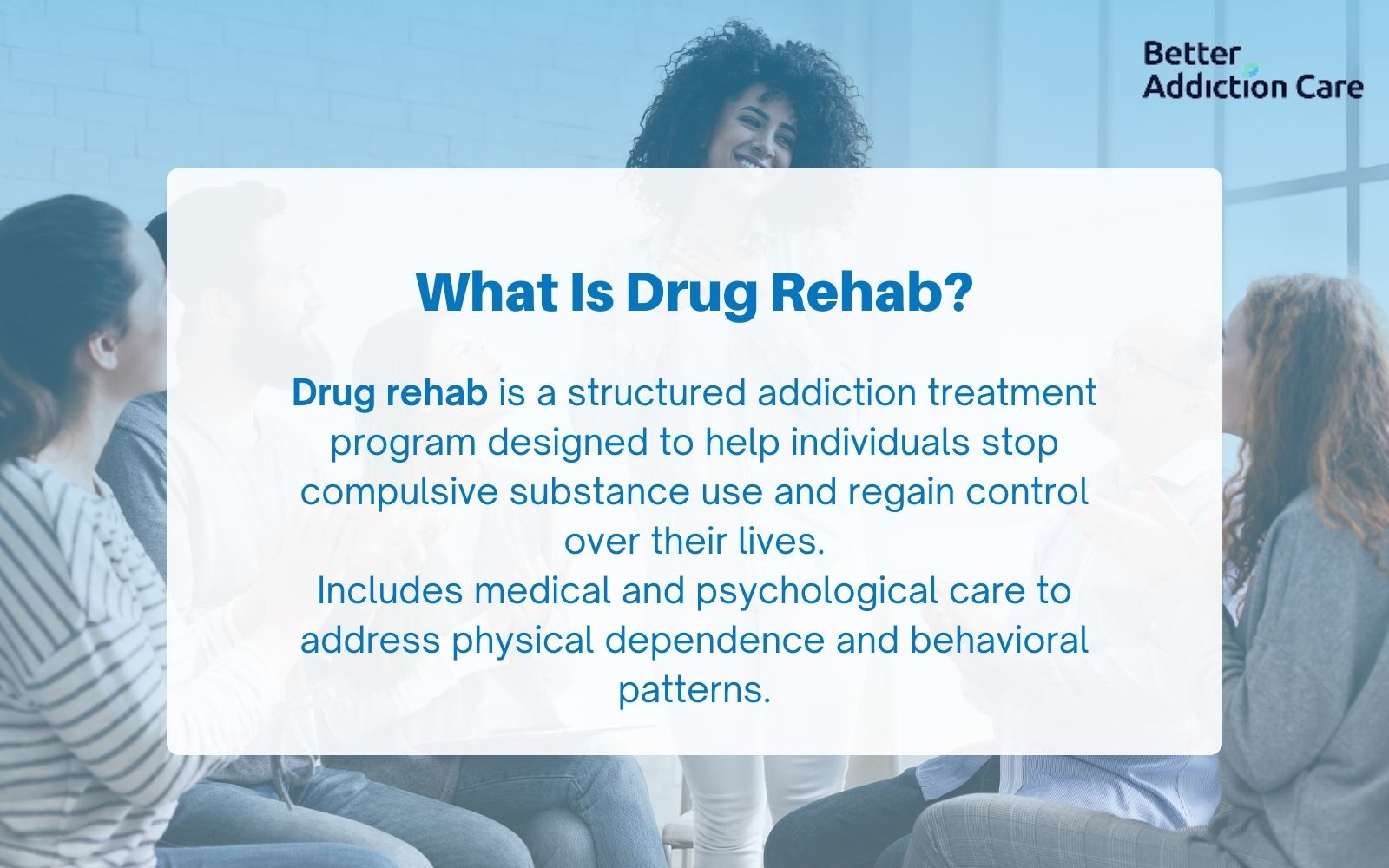
What Are Different Types of Drug Rehab?
The different types of drug rehab are inpatient rehab, outpatient programs, luxury rehab, faith-based centers, and state-funded facilities, each offering different levels of addiction treatment based on individual needs. Some programs provide 24-hour medical supervision, while others allow flexibility for those balancing treatment with daily responsibilities.
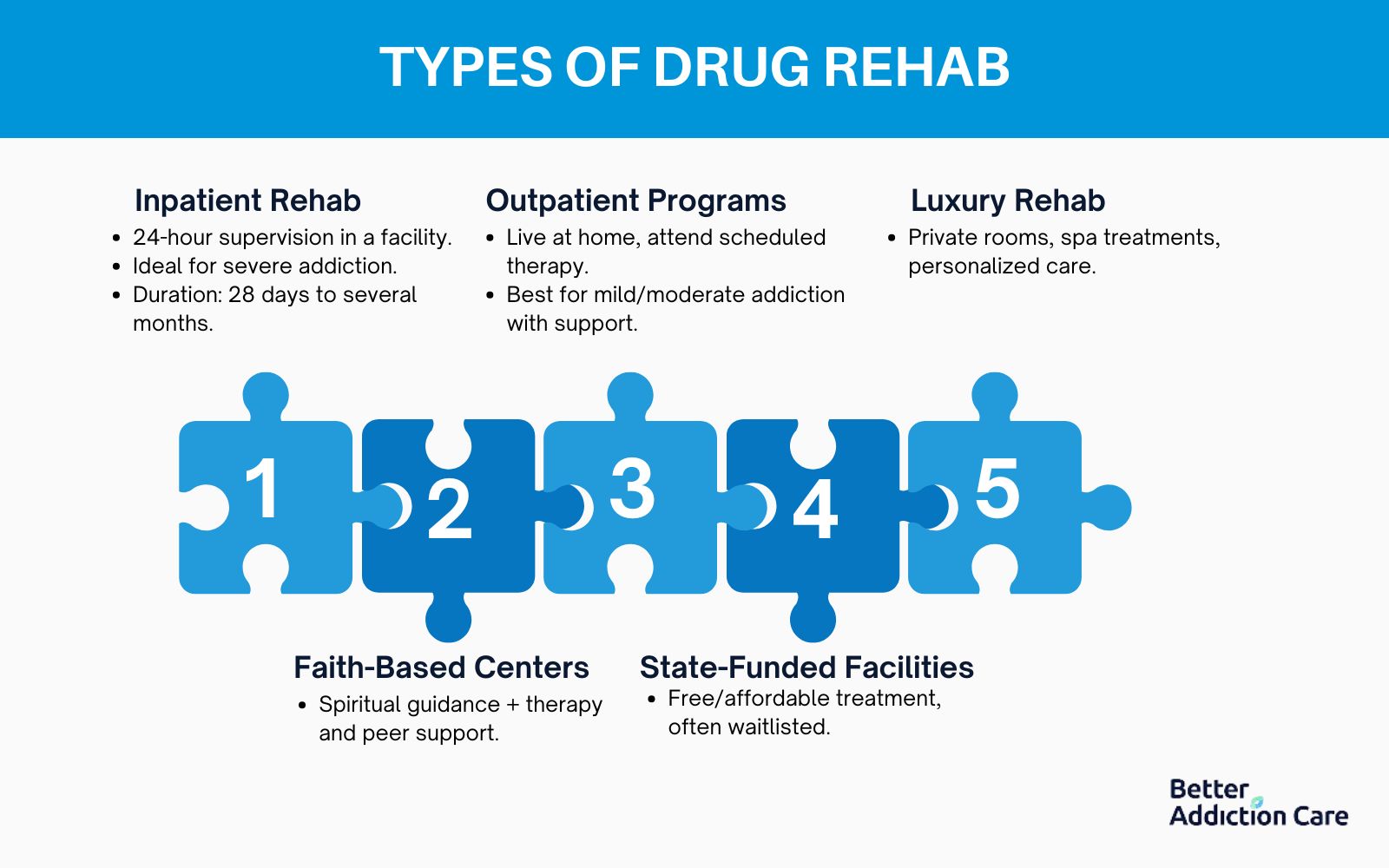
-
Inpatient Rehab: This program provides 24-hour medical supervision in a structured facility, making it ideal for individuals with severe addiction. Treatment lasts from 28 days to several months.
-
Outpatient Programs: These programs allow individuals to continue living at home while attending scheduled therapy sessions. Outpatient care is best suited for those with mild to moderate addiction who have strong support systems.
-
Luxury Rehab: High-end rehab centers offer private rooms, spa treatments, and personalized care. While they provide comfort, treatment quality depends on the facility and staff expertise.
-
Faith-Based Centers: These programs incorporate spiritual guidance into addiction recovery, combining religious principles with therapy and peer support.
-
State-Funded Facilities: Government-funded centers provide affordable or free treatment for individuals who cannot afford private rehab. They offer important services but have waitlists due to high demand.
What Are Specialty Rehab Centers and Who Are They For?
Specialty rehab centers are treatment facilities designed for specific populations, such as veterans, adolescents, LGBTQ+ individuals, and those with dual diagnoses, to provide targeted addiction treatment that meets their unique needs. These centers offer specialized care that addresses the challenges faced by different groups in recovery.
The following are common types of addiction rehab programs that provide tailored support:
-
Veterans Rehab Centers: These programs focus on military personnel and veterans dealing with addiction rehab programs and co-occurring conditions like PTSD. Treatment includes trauma-informed therapy and relapse prevention strategies.
-
Adolescent Rehab Centers: These facilities provide evidence-based therapies tailored to young individuals struggling with substance use. Programs focus on peer support, behavioral therapy, and early intervention to prevent long-term addiction.
-
LGBTQ+ Rehab Centers: These centers offer inclusive addiction treatment designed for LGBTQ+ individuals, addressing discrimination, mental health concerns, and identity-related stressors that contribute to substance use. A meta-analysis published in the Journal of Studies on Alcohol and Drugs found that lesbian, gay, and bisexual (LGB) adolescents had, on average, 190% higher odds of substance use compared to their heterosexual peers.
-
Dual Diagnosis Treatment Centers: These programs treat individuals with both substance use disorders and mental health conditions. Dual diagnosis treatment integrates psychiatric care with evidence-based therapies for a comprehensive recovery approach. According to the Substance Abuse and Mental Health Services Administration (SAMHSA), in 2019, there were 13.1 million Americans with a serious mental illness, and more than 3.5 million (approximately 27%) of these individuals also had a substance use disorder.
-
Opioid Treatment Programs: These centers specialize in treating opioid use disorder through medication-assisted treatment (MAT) combined with behavioral counseling. According to the Substance Abuse and Mental Health Services Administration (SAMHSA) in the 2020 National Survey of Substance Abuse Treatment Services (N-SSATS), 8–11% of facilities between 2010 and 2020 were opioid-specific treatment centers, reflecting the need for specialized care.
What Is a Typical Day in Drug Rehab?
A typical day in drug rehab follows a structured schedule that helps individuals focus on recovery while developing healthy routines. Daily activities include therapy sessions, educational workshops, and recreational activities to promote healing and skill-building for long-term sobriety.
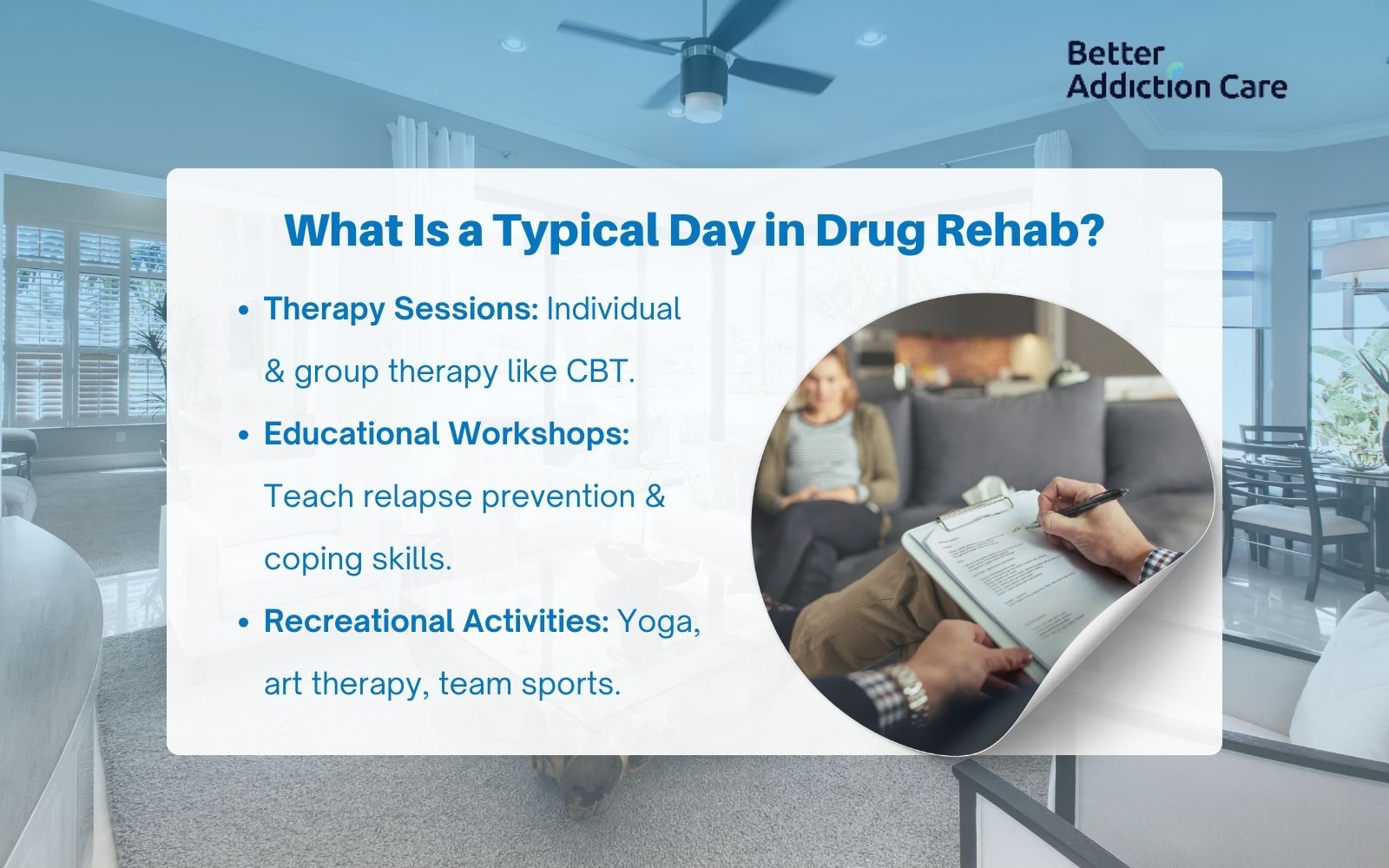
The following are key components of a daily rehab program:
-
Therapy Sessions: Individual and group therapy provides emotional support and helps individuals explore the root causes of addiction. Cognitive Behavioral Therapy (CBT) and other evidence-based therapies are commonly used.
-
Educational Workshops: Classes focus on understanding addiction, managing cravings, and developing coping skills. These sessions teach relapse prevention strategies and stress management techniques.
-
Recreational Activities: Physical exercise, meditation, and creative hobbies help reduce stress and improve mental well-being. Activities such as yoga, art therapy, and team sports encourage a balanced lifestyle.
Can You Work or Study During Drug Rehab?
Yes, it is possible to work or study during drug rehab, depending on the program's structure and individual circumstances. Outpatient programs allow participants to maintain their employment or educational commitments while attending scheduled treatment sessions. Conversely, inpatient programs have more restrictive policies but sometimes offer flexible arrangements to accommodate work or study needs. Balancing these responsibilities requires careful planning and support from the treatment facility to ensure that recovery remains the primary focus.
How Do Family Involvement and Support Systems Occur in Drug Rehab?
Family involvement and support systems play an important role in the rehabilitation process. Family dynamics are addressed through therapy sessions that aim to heal relationships and establish healthy communication patterns. Visiting policies vary by facility but encourage family support to strengthen the support network. External support networks, such as community groups, also provide additional layers of encouragement and accountability. For example, the Community Reinforcement Approach and Family Training (CRAFT) model has been effective in engaging treatment-resistant individuals, with success rates of around 70% in getting loved ones into treatment.
What Programs Are Offered in Drug Rehab?
Programs offered in drug rehab include detox, inpatient, outpatient, PHP, behavioral therapy and family and group therapy. These programs are tailored to meet the individuals needs and help them progress through the different levels of care and prevent relapse.
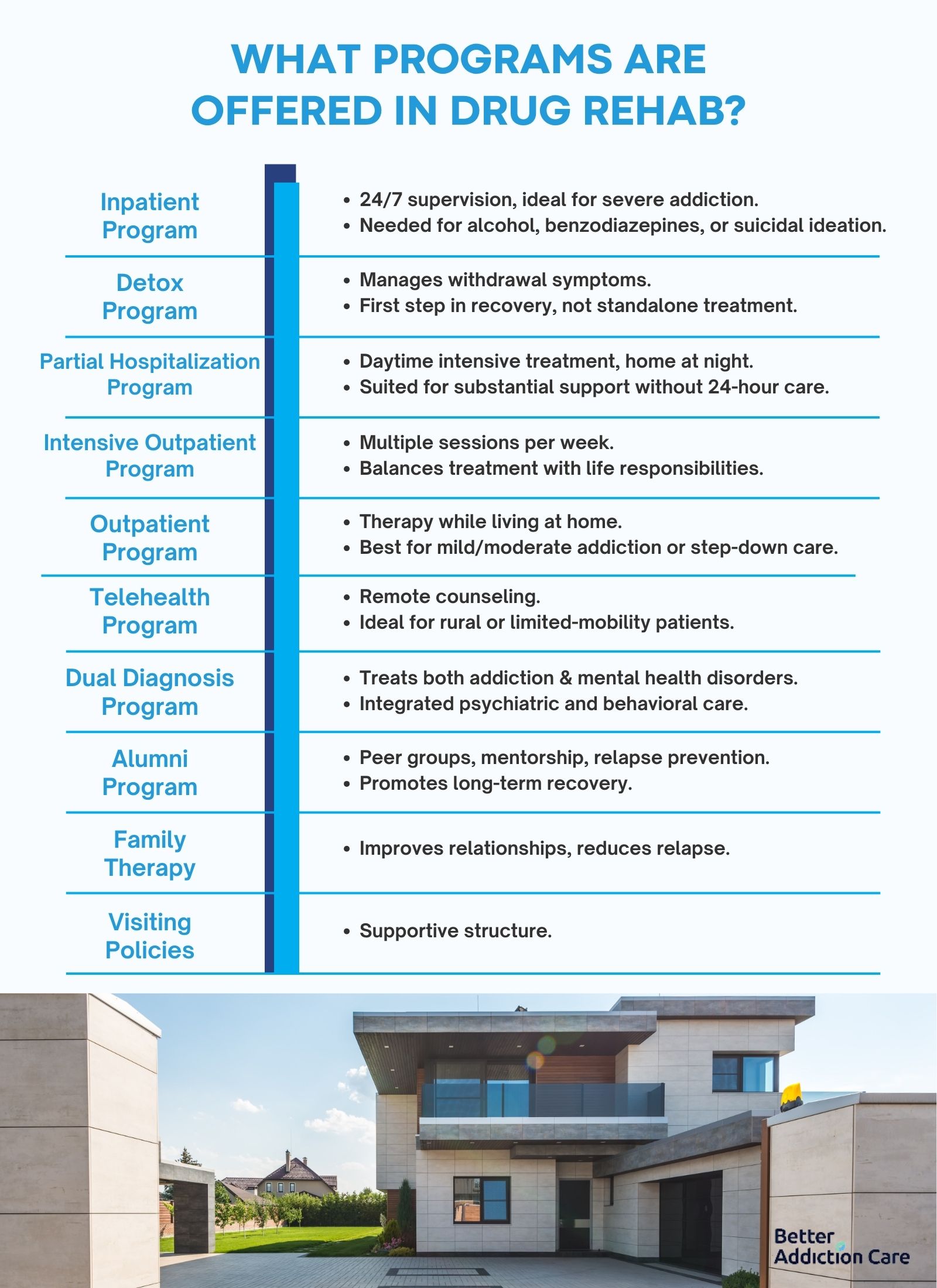
The programs in drug rehab are detailed below:
Inpatient Drug Rehab Program
The inpatient program provides 24-hour medical supervision in a structured setting, making it ideal for individuals with severe addiction or those at risk of dangerous withdrawal symptoms. Substances such as alcohol and benzodiazepines require inpatient detox due to the risk of seizures and other life-threatening complications.
For those seeking comprehensive care, an inpatient drug rehab program offers personalized treatment plans, therapy sessions, and round-the-clock support to help patients achieve long-term recovery.
Drug Detox Program
The drug detox program is designed to safely remove substances from the body while managing withdrawal symptoms. Medical drug detox is important for substances like opioids, alcohol, and benzodiazepines, as withdrawal from these drugs causes severe physical and psychological distress. Detox alone is not a full treatment but rather a first step in recovery, requiring follow-up care through inpatient or outpatient programs. According to SAMHSA in 2014, about one-fifth of addiction treatment admissions are for detoxification.
Partial Hospitalization Program
The Partial Hospitalization Program (PHP) is a structured outpatient program that provides intensive care while allowing individuals to return home in the evenings. PHP is recommended for those who need substantial support but do not require 24-hour supervision. However, individuals referred to PHP who exhibit worsening psychiatric symptoms, including suicidal ideation, are at greater risk of needing inpatient hospitalization, as noted by Beard et al. (2016) in "When Partial Hospitalization Fails: Risk Factors for Inpatient Hospitalization."
Intensive Outpatient Program
The Intensive Outpatient Program (IOP) provides structured therapy sessions multiple times per week, allowing individuals to receive comprehensive treatment while maintaining work, school, or family responsibilities. IOP is beneficial for those who require more support than standard outpatient care but do not need hospitalization. These programs include cognitive-behavioral therapy, relapse prevention strategies, and medication-assisted treatment when necessary.
Outpatient Program
The outpatient program offers flexible treatment for individuals with mild to moderate addiction who maintain daily responsibilities. These programs involve scheduled therapy sessions, such as individual counseling and group therapy, without requiring overnight stays. Outpatient care is also a step-down option for those transitioning from inpatient or intensive treatment programs.
Telehealth Program
The telehealth program provides addiction treatment through remote counseling, increasing accessibility for individuals in rural areas or those with mobility limitations. Ethical considerations in telehealth, such as patient confidentiality and continuity of care, are important in ensuring the effectiveness of virtual treatment. According to Chaet et al. (2017) in "Ethical Practice in Telehealth and Telemedicine," telehealth must maintain the same ethical standards as in-person care, ensuring that individuals receive high-quality treatment.
Dual Diagnosis Program
The dual diagnosis program is designed for individuals with co-occurring substance use and mental health disorders, such as depression, anxiety, or bipolar disorder. Integrated treatment is important, as untreated mental health conditions contribute to addiction relapse. Braquehais et al. (2014) in "Dual Diagnosis Among Physicians: A Clinical Perspective" show that dual diagnosis is particularly common in high-stress professions, emphasizing the need for specialized care.
Alumni Program
The alumni program provides ongoing support for individuals who have completed rehab, helping them stay connected to their recovery community. These programs include peer support groups, mentorship, and relapse prevention workshops. Continued engagement through alumni programs has been shown to improve long-term recovery outcomes. According to the National Institute on Drug Abuse, approximately 50% of individuals who complete treatment for substance use disorders remain abstinent, and participation in aftercare programs can significantly improve these outcomes.
How Are Evidence-Based Practices Used During Drug Rehab?
Evidence-based practices are used during drug rehab by incorporating therapies like Cognitive Behavioral Therapy (CBT) and Motivational Interviewing (MI) to help individuals overcome addiction. These methods address harmful thought patterns, improve coping strategies, and reduce relapse risks. Holistic approaches like meditation and recreational activities support overall well-being.
The evidence-based therapies used during drug rehab are listed below:
-
Cognitive Behavioral Therapy (CBT): CBT helps individuals identify and change negative thought patterns that contribute to substance use. This therapy has been proven to increase long-term abstinence rates by improving coping mechanisms and reducing relapse triggers. A meta-analysis published in the Journal of Consulting and Clinical Psychology evaluated the efficacy of CBT for alcohol and other drug use disorders. The study found that CBT outcomes were approximately 15% to 26% better than those in untreated or minimally treated control groups.
-
Dialectical Behavior Therapy: DBT focuses on emotional regulation and distress tolerance, making it especially useful for individuals with co-occurring disorders. By combining mindfulness techniques with behavioral strategies, DBT helps manage cravings and emotional triggers. A 2015 study reported a 29% reduction in substance use after one year of DBT treatment, highlighting its potential in addressing substance misuse according to DBTUK titled Stats Around DBT: Evidence, Success Rates, and Impact
-
Motivational Interviewing (MI): MI enhances motivation for change by resolving ambivalence and reinforcing personal goals. This therapy increases treatment engagement and has been shown to improve long-term recovery outcomes.
-
Community Reinforcement Approach (CRA): CRA encourages sobriety by replacing substance use with rewarding, sober activities. CRA improves treatment retention and reduces relapse rates by reinforcing positive behaviors.
-
Holistic Methods: These methods, such as meditation, yoga, and recreational activities, complement traditional therapies by reducing stress and enhancing self-awareness. These practices help individuals develop healthier coping mechanisms and maintain sobriety.
What Medications Are Used in Drug Rehab?
Medications used in drug rehab include Methadone, Buprenorphine/Naloxone (Suboxone), and Naltrexone for opioid addiction, as well as Disulfiram (Antabuse) and Acamprosate for alcohol dependence. These medications help manage withdrawal symptoms, reduce cravings, and prevent relapse, making recovery more achievable when combined with behavioral therapy.
Medications used in drug rehab are listed below:
-
Methadone is used for opioid addiction, particularly heroin dependence. It helps reduce cravings and withdrawal symptoms, improving treatment retention. Methadone maintenance therapy significantly lowers opioid use over time. According to the National Institute on Drug Abuse (NIDA), patients stabilized on adequate, sustained doses of methadone or buprenorphine can maintain employment, avoid crime and violence, and reduce their exposure to HIV and Hepatitis C by ceasing or decreasing injection drug use and associated high-risk sexual behavior.
-
Buprenorphine/Naloxone (Suboxone) is a combination medication that treats opioid use disorder. Buprenorphine relieves cravings, while naloxone prevents misuse by blocking opioid effects.
-
Naltrexone is an opioid antagonist that blocks the effects of opioids and alcohol, reducing relapse risks. Individuals taking naltrexone experience lower relapse rates than those in non-medicated treatments. This medication blocks the euphoric effects of alcohol and opioids. Studies have shown that naltrexone reduces the risk of relapse in the first three months by approximately 36%. However, retention rates at 90 days average 12% for naltrexone, compared to 57% for buprenorphine and 61% for methadone, according to the National Evaluation of Pharmacotherapies for Opioid Dependence.
-
Disulfiram (Antabuse) is prescribed for alcohol addiction by creating unpleasant physical reactions when alcohol is consumed. This aversion therapy discourages drinking and supports long-term sobriety.
-
Acamprosate helps maintain abstinence in individuals with alcohol dependence by restoring chemical imbalances in the brain caused by alcohol use.
Can Drug Rehab Centers Treat Co-Occurring Mental Health Disorders?
Yes, drug rehab centers can treat co-occurring mental health disorders. These disorders, known as dual diagnosis, involve the simultaneous presence of a substance use disorder and a mental health condition. Treatment approaches integrate dual diagnosis treatment, addressing both issues concurrently to improve overall outcomes. This comprehensive strategy has been effective in promoting recovery and reducing relapse rates. Co-occurring disorders, also known as dual diagnoses, refer to the simultaneous presence of a mental health disorder and a substance use disorder. According to the 2011 U.S. National Survey on Drug Use and Health, 17.5% of adults with a mental illness also had a co-occurring substance use disorder, equating to approximately 7.98 million individuals.
How Do Drug Rehab Centers Address Relapse Prevention in Their Programs?
Drug rehab centers address relapse prevention by developing individualized plans that include identifying triggers and building effective coping mechanisms. Techniques such as cognitive-behavioral therapy help patients recognize situations that lead to relapse and develop strategies to handle them. Centers also provide resources like aftercare programs, which offer ongoing support post-treatment, and sober living arrangements to facilitate a stable environment. Relapse is a common aspect of the recovery process. The National Institute on Drug Abuse (NIDA) reports that relapse rates for substance use disorders are comparable to those of other chronic illnesses, such as diabetes and hypertension, ranging from 40% to 60%. Engaging alumni networks further supports sustained recovery by connecting individuals with peers who have successfully maintained sobriety. These comprehensive approaches have been shown to enhance long-term recovery outcomes.
Who Needs Drug Rehab?
Individuals with substance use disorder (SUD) need drug rehab. SUD is characterized by the persistent use of drugs despite substantial harm and adverse consequences to oneself and others.
People who need drug rehab are listed below:
-
Individuals experiencing withdrawal symptoms: Withdrawal occurs when drug use is reduced or stopped, leading to symptoms such as nausea, anxiety, and severe cravings. These symptoms are dangerous and require medical supervision in a rehab setting. Treatment provides medications and therapies to ease withdrawal and support long-term recovery.
-
Those with increased drug tolerance: Increased tolerance means needing larger amounts of a drug to achieve the same effect, signaling dependence. This leads to higher drug consumption, increasing the risk of overdose. Rehab helps individuals break this cycle and develop healthier coping mechanisms.
-
Individuals engaging in risky behaviors due to drug use: Risky behaviors, such as unsafe sex or driving under the influence, indicate a loss of control over substance use. These actions result in accidents, injuries, or legal trouble. Rehab addresses the root cause of these behaviors and promotes safer decision-making.
-
People facing legal issues related to substance abuse: Drug-related arrests, DUI charges, and court mandates for treatment suggest a serious substance problem. Legal troubles reflect the impact of addiction on judgment and behavior. Rehab offers structured programs to help individuals avoid future offenses and rebuild their lives.
-
Those with deteriorating physical or mental health: Chronic drug use contributes to conditions like liver disease, heart problems, depression, and anxiety. These health issues worsen over time without intervention. Rehab provides medical and psychological support to restore overall well-being.
-
Individuals struggling with failed attempts to quit: Repeatedly trying and failing to stop using drugs is a sign that professional help is needed. The inability to quit alone leads to frustration and deeper addiction. Rehab offers evidence-based treatments that increase the likelihood of long-term recovery.
-
People whose relationships are affected by drug use: Addiction damages relationships with family, friends, and colleagues due to erratic behavior, dishonesty, or neglect. Strained relationships lead to isolation, worsening the addiction cycle. Rehab provides counseling to rebuild trust and improve communication.
-
Those experiencing financial problems due to substance abuse: Spending excessive money on drugs leads to job loss, debt, and financial instability. Many individuals prioritize drug use over basic needs, worsening their situation. Rehab helps individuals regain financial control by addressing the addiction’s root causes.
-
Individuals neglecting responsibilities at work, school, or home: Addiction interferes with daily life, leading to missed deadlines, poor performance, and conflicts with employers or loved ones. This neglect results in job loss, academic failure, or family breakdown. Rehab helps individuals restore stability and accountability in their lives.
How Are Privacy and Confidentiality Protected in Drug Rehab?
Privacy and confidentiality are protected in drug rehab through HIPAA regulations, strict patient data handling policies, and staff confidentiality training. HIPAA (Health Insurance Portability and Accountability Act) establishes legal standards to ensure that patient records remain private and secure. Rehab facilities must comply with these regulations by limiting access to sensitive information and obtaining patient consent before disclosure. As noted by McMahon and Lee-Huber (2001) in the study "HIPAA Privacy Regulations: Practical Information for Physicians," these rules control how health data is used and disclosed, ensuring patient privacy.
Patient data handling in drug rehab centers follows strict security measures to prevent unauthorized access. Facilities use encrypted electronic records, locked paper files, and restricted access protocols to safeguard information. These procedures ensure that only authorized personnel view patient records, reducing the risk of data breaches.
Staff confidentiality training is required to protect patient privacy in drug rehab. Employees receive instruction on HIPAA compliance, ethical standards, and legal responsibilities regarding patient information. Regular training ensures that staff members understand privacy laws and follow proper procedures when handling sensitive data. Compliance with these regulations enhances trust and protects individuals seeking addiction treatment.
How to Choose the Right Rehab Center Near Me?
To choose the right rehab center near you, it is important to evaluate amenities, offered programs, staff credentials, cost, location, and patient testimonials. A facility with medical detox services, individualized care, and treatment diversity ensures a comprehensive approach to addiction recovery. The right local rehab center should provide evidence-based therapies, address co-occurring conditions, and offer relapse prevention strategies. Financial considerations, insurance coverage, and rehab facility walkthrough visits also play a role in making an informed decision.
To choose the right rehab center, follow these steps:
Step 1: Evaluate the Rehab Center's Amenities
Evaluating the rehab center’s amenities helps determine if the facility provides important services for addiction recovery. Licensed rehab centers offer structured programs with medical supervision, therapy options, and relapse prevention strategies. Some facilities include luxury accommodations, holistic treatments, and recreational activities, while others focus on important medical and therapeutic services. Verifying accreditation ensures the center meets professional standards for effective treatment.
Step 2: Understand Offered Programs and Treatments
Understanding offered programs and treatments ensures that the rehab center provides treatment diversity and individualized care for addiction recovery. Programs range from medication-assisted treatment for opioid use disorder to behavioral therapies for long-term sobriety. Some facilities specialize in co-occurring mental health disorders or trauma-focused therapy, improving treatment outcomes. According to the National Institute on Drug Abuse (2018) in “Principles of Drug Addiction Treatment: A Research-Based Guide,” matching treatment to individual needs increases success rates.
Step 3: Assess Facility Quality and Staff Credentials
Assessing facility quality and staff credentials ensures the rehab center has experienced professionals providing evidence-based care. Certified addiction specialists, licensed therapists, and medical professionals contribute to a well-rounded treatment team. A lower patient-to-staff ratio allows for more personalized care and better recovery outcomes. Facilities with specialized staff trained in dual diagnosis treatment offer more comprehensive support for individuals with co-occurring disorders.
Step 4: Review Cost and Insurance Coverage
Reviewing cost and insurance coverage helps determine affordability and access to treatment. Many rehab centers accept private insurance, Medicaid, or government-funded programs to reduce financial burdens. Some facilities offer payment plans or financial assistance for those without coverage. As noted by the National Institute on Drug Abuse (2018) in “Principles of Drug Addiction Treatment: A Research-Based Guide,” financial accessibility improves treatment engagement and long-term recovery outcomes. It’s always best to verify your insurance to see what rehab center is the best fit for you.
Step 5: Consider Location and Accessibility
Location and accessibility help individuals decide between a rehab center close to home or one in a more secluded environment. Nearby treatment centers allow for family involvement and easier transitions post-rehab, while remote locations provide a distraction-free setting for intensive recovery. Some facilities integrate urban programs with employment assistance, while others offer nature-based therapies for relaxation and healing.
Step 6: Check Reputation and Patient Testimonials
Checking reputation and patient testimonials provides insight into a rehab center’s effectiveness and credibility. Online reviews, personal recommendations, and treatment success rates help gauge overall quality. Facilities with high completion rates and strong alumni networks indicate long-term sobriety support. Word-of-mouth referrals from former patients or healthcare professionals further confirm a center’s reputation.
Step 7: Visit and Ask Questions
Visiting and asking questions during a rehab facility walkthrough allows individuals to evaluate the center’s environment and staff interactions. Observing cleanliness, safety measures, and daily routines offers insight into the rehab experience. Speaking with current patients or alumni provides first-hand perspectives on treatment effectiveness and overall support systems.
How Accreditation Impacts Quality of Care at a Drug Rehab Center?
Accreditation impacts the quality of care at a drug rehab center by ensuring the implementation of evidence-based treatments and continuous quality improvement. Accredited facilities follow strict guidelines that enhance patient safety, treatment effectiveness, and overall recovery outcomes. The Commission on Accreditation of Rehabilitation Facilities (CARF) sets rigorous standards for addiction treatment centers, ensuring they meet ethical and medical benchmarks. While direct numerical data on accreditation’s effect on recovery rates is limited, accredited centers are more likely to provide structured care that leads to long-term sobriety. According to CARF, 29.6% of addiction treatment facilities were accredited in 2020, highlighting a commitment to recognized quality assurance.
How Much Does It Cost to Enter a Drug Rehab Center in the US?
The cost to enter a drug rehab center in the US varies by treatment type, with methadone treatment averaging $12,183 per episode, intensive outpatient programs costing $4,939, and residential treatment reaching $9,766. The national average cost for addiction treatment is $13,475, though expenses fluctuate depending on the facility, program duration, and location. Luxury rehab centers charge upwards of $80,000 per month, while state-funded programs or outpatient services are available for a fraction of the cost. Financial accessibility plays an important role in treatment success, making it important for individuals to explore insurance options, payment plans, and state-funded resources before entering rehab.
Below are some examples of average costs by program type:
|
State |
Outpatient Treatment |
Residential Treatment |
Detox Programs |
|
Florida |
$1,700 |
$58,000 |
$6,000 |
|
New Jersey |
$1,800 |
$60,000 |
$6,500 |
|
Illinois |
$1,750 |
$55,000 |
$5,500 |
|
Arizona |
$1,706 |
$56,789 |
$6,000 |
Insurance coverage for rehab treatment varies by provider and plan type. Most policies classify inpatient rehab under behavioral health or substance use disorder treatment, each with distinct coverage rules. Many require preauthorization, meaning approval must be obtained before admission. Without it, claims may be denied.
Our comprehensive rehab locator tool connects you with quality treatment facilities across California, Illinois, Texas, New York, Florida, Massachusetts, Oklahoma, Georgia, and Pennsylvania. It helps you find vetted centers that match your specific needs, recovery preferences, and insurance coverage. By searching by location and insurance compatibility, you identify facilities that accept your plan and meet coverage requirements, making your path to recovery more accessible and tailored to your circumstances.
What Are the Pros and Cons of Choosing a Local vs. Distant Drug Rehab Center?
The pros and cons of choosing a local vs. distant drug rehab center depend on factors such as accessibility, support networks, and treatment options. A local rehab center allows individuals to stay close to family while accessing outpatient treatment without the burden of travel. A distant rehab center provides a fresh start, separating individuals from triggers and negative environments that contribute to addiction. Privacy, cost, and available treatment approaches also play a role in deciding between local and distant options.
Comparison of Local vs. Distant Drug Rehab Centers is shown below:
|
Aspect |
Local Rehab Centers |
Distant Rehab Centers |
|
Pros |
- Familiar Environment: Staying close to home provides comfort and ease during treatment. - Support Network: Allows maintenance of connections with friends, family, and other support systems. |
- Expanded Options: Access to a wider range of treatment options, specialties, and amenities. - Enhanced Privacy: Offers increased privacy and anonymity, reducing concerns about potential stigma. |
|
Cons |
- Limited Options: The availability of rehab centers is restricted, limiting treatment approaches and amenities. - Privacy Concerns: Possibility of encountering familiar faces during treatment, raising confidentiality issues. |
- Limited Support Network: Being far from home limits access to existing support systems. - Disruption to Daily Life: Requires temporary relocation, disrupts daily routines and causes stress for loved ones. |
Is There a Difference Between Drug Rehab and Alcohol Rehab?
Yes, there is a difference between drug rehab and alcohol rehab, primarily due to the distinct nature of the substances involved and their effects on the body. Alcohol is a central nervous system depressant, leading to specific withdrawal symptoms that are severe and require specialized medical supervision during detoxification.
Related Articles
Treatment Centers in Virginia




